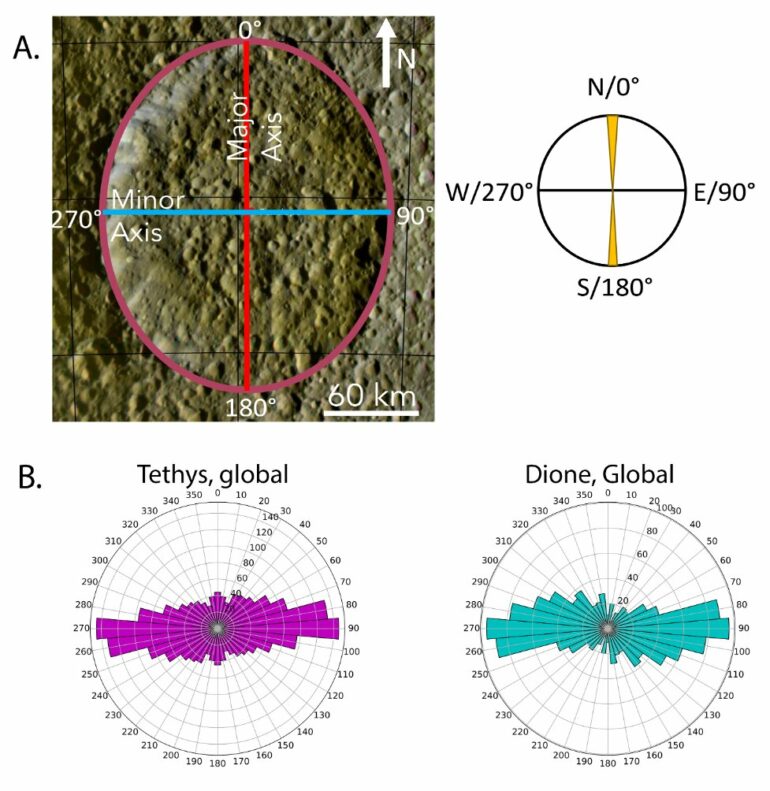A new SwRI study describes how unique populations of craters on two of Saturn’s moons could help indicate the satellites’ age and the conditions of their formation. Using data from NASA’s Cassini mission, SwRI postdoctoral researcher Dr. Sierra Ferguson surveyed elliptical craters on Saturn’s moons Tethys and Dione for this study, which was co-authored by SwRI Principal Scientist Dr. Alyssa Rhoden, Lead Scientist Dr. Michelle Kirchoff and Lead Analyst Dr. Julien Salmon.
“Our work aims to answer the broader question of how old these moons are. To get at this question, my colleagues and I mapped elliptical craters on the surfaces of these moons to determine their size, direction and location on the moon,” Ferguson said.
Circular craters are very common and can be formed from a wide range of impact conditions. However, elliptical craters are rarer and form from slow and shallow impacts, which make them especially useful in determining an object’s age because shape and orientation also indicate their impactor’s trajectory.
“By measuring the direction these craters point, we can get an idea of what the impactors that made these craters looked like in a dynamical sense and from which direction they might have hit the surface,” she said.
At first, Ferguson was not expecting to find a pattern among the directions of the elliptical craters, but she eventually noticed a trend along the equator of Dione, one of Saturn’s small moons. There, elliptical craters were overwhelmingly oriented in an east/west pattern, while the directions were more random close to the moon’s poles.
“We initially interpreted this pattern to be representative of two distinct impactor populations creating these craters,” she said. “One group was responsible for creating the elliptical craters at the equator, while another, less concentrated population may be more representative of the regular background population of impactors around Saturn.”
Ferguson also mapped elliptical craters on Tethys, Saturn’s fifth largest moon, and found that a similar size-frequency distribution of craters is unusual for objects orbiting the Sun, but curiously matches estimates for the impactor population that appears to be present on Neptune’s moon, Triton. Because that population is thought to be planetocentric, or drawn in by the ice giant’s massive gravity, Ferguson’s results point to the importance of considering planetocentric impactors when examining the age of objects in the Saturnian system.
“It was really astonishing to see these patterns,” she said.
Ferguson believes the equatorial craters could have formed from independent disks of debris orbiting each moon or potentially a single disk that affected both moons.
“Using Triton as a guide, Tethys could reasonably be billions of years old. This age estimate is dependent on how much material was available for impacting the surface and when it was available,” Ferguson said. “To be certain, of course, we will need more data, but this research tells us a lot. It can give us an idea of what the formation conditions of these moons were like. Was this a system that was completely chaotic with materials hitting these satellites every which way, or was there a neat and orderly system?”
Ferguson hopes to eventually be able to compare her data from the Saturnian moons to those of Uranus, another ice giant. While current data is inconclusive, one of the flagship missions recommended by the Planetary Science Decadal Survey, which was published in April, is a mission to Uranus and its moons.
“This is the first step toward a new perspective on the cratering history of these moons and their origin and evolution,” Ferguson said.
The study is published in Earth and Planetary Science Letters.
More information:
Sierra N. Ferguson et al, A unique Saturnian impactor population from elliptical craters, Earth and Planetary Science Letters (2022). DOI: 10.1016/j.epsl.2022.117652
Provided by
Southwest Research Institute
Citation:
Researcher shows how elliptical craters could shed light on age of Saturn’s moons (2022, June 21)
